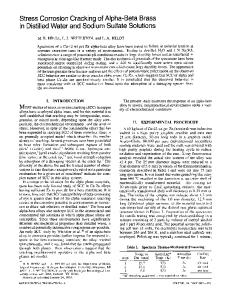Stress gradients and extent of slip in alpha brass
- PDF / 1,676,066 Bytes
- 10 Pages / 594 x 774 pts Page_size
- 29 Downloads / 250 Views
I.
INTRODUCTION
IN a recent paper
on dislocation arrangements in stress gradients, [1] it was calculated that for a given number of dislocations, the dislocations would travel farther beyond the critical resolved shear stress position on the slip plane if the applied stress gradients were shallow rather than steep. This paper presents the results of experiments to test this calculation. II.
EXPERIMENTAL PROCEDURES
The 70-30 alpha brass single crystals, 1.8 cm in diameter and 10 cm in length, were grown by the Bridgman technique. To obtain stress gradients, wedge-shaped compression specimens were prepared. Two samples, specimens 1 and 2, were spark cut from one single-crystal bar. The third rectangular compression sample, specimen 3, was cut from the same single crystal to determine stress-strain relations. The specimen configuration and final dimensions are given in Table I. Following spark cutting, the specimens were mounted in a jig and mechanically polished. The specimens were then annealed for 4 hours at 350 ~ After this anneal, the specimens were given a series of electropolishings, until etch pitting revealed no dislocations arranged in a slip band pattern. Lane photographs, after the last electropolishing, revealed no asterism. The electropolishing solution consisted of 50 pct phosphoric acid and 50 pet methanol. The etch pitting solution, first used by Jacquet, [2] was composed of 300 ml water, 0.7 g sodium thiosulphite, and 0.0125 g ferric chloride. A current density of 0.09 A / c m 2 was employed to produce etch pitting. In carrying out the etch pitting, it was considered that the final position of the leading dislocation could depend on whether etch pitting was carried out while the specimen was still under stress or after removal from the compression machine. Under stress, it was possible that XIAOYU HU, Postdoctoral Student, and HAROLD MARGOLIN, Professor, are with the Department of Metallurgy and Materials Science, Polytechnic University, Brooklyn, NY 11201. Manuscript submiued May 29, 1990. METALLURGICAL TRANSACTIONS A
additional movement of the leading dislocation could occur or, on removal, backward movement could take place. Because of these possibilities, both procedures were employed. A special device was necessary to permit etching to take place under load. The orientations of the compression axis of the slip extent samples, specimens 1 and 2, and the compression axis of the stress-strain sample, specimen 3, are given in Figure 1(a), and the orientation of the front face, on which slip observations were made, is shown in Figure l(b). Specimen 2 was etch pitted under load; specimen 1 without load.
III. F I N I T E E L E M E N T METHOD CALCULATION To calculate the stress distribution in a wedged-shaped specimen when slip on a single slip system or multiple slip systems has taken place, it was necessary to develop a finite element method (FEM) program to take the behavior of slip into account. The theoretical background and the numerical technique for this consideration are given in the fol
Data Loading...











